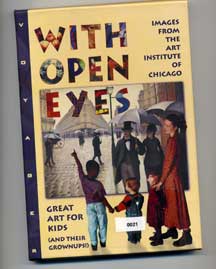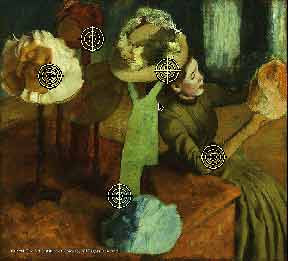To the right is a screen shot of the CD used in the lesson on this page. The CD has 200 full-screen, color reproductions of objects from the Art Institute of Chicago's collection.

Here is the information about the CD ROM used in this lesson:
The Art Institute of Chicago and Voyager,1995 Macintosh/Windows Hybrid$39.95
The above information is from the ART INSTITUTE OF CHICAGO'S WEB SITE.

The works of art on the CD can be accessed by geography or time period. On each side is a screen shot of the two different interfaces.
The CD also has games, music, sound effects, poetry, and narrated information.
This lesson uses the full screen images on the CD, like the picture of Dega's painting of the young hat maker to the right.
The image is projected from a computer onto the wall so that all students can easily see the painting.



Blindman Sees the Painting in his Mind Game
This lesson can be taught in any room with a computer that can project a large image onto a wall or screen.
Objective: Get students to analyze pieces of art and verbalize what they see.
1st: As students enter the art room have them each take a number. The numbers are on little strips of paper laid out on a table. The first child in the room gets number 1. The second child gets number 2, and so on. When the last student enters the room and gets the last number, he or she is the "Blindman". (This discourages students from being late to class!)
2nd: The "Blindman" then turns his or her back to the screen where the image of a work of art will soon be projected. It helps add to the drama to actually blindfold the student.
3rd: The image gets projected on the wall for everyone but the "Blindman" to see. The object of the game is to try to have the "Blindman" visualize what the picture looks like in his or her imagination by the descriptions his or her classmates give.
4th: The student with number 1 goes first. The "Blindman" has to ask a question to try to get some information about the picture BUT each student can only tell about one aspect about the picture. Here is an example:
"Blindman" What is the main color?
Student number 1 Orange is the main color.
"Blindman" Is it inside or outside ?
Student number 2 It is inside.
"Blindman" Are there any animals?
Student number 3 There are no animals.
"Blindman" Are there people in the picture?
Student number 4 Yes there is a person in the picture.
"Blindman" What is the person doing?
Student number 5 The person is making a hat?
"Blindman" What does the hat look like?
Student number 6 It is small and white with some orange?
"Blindman" What is the person who is making a hat wearing?
Student number 7 She is wearing a long green dress?
"Blindman" What kind of person would wear the hats?
and on and on
5th: Then the blindman takes off the blindfold and looks at the picture to see if it looks like the one he or she made in his or her imagination.
Now everyone is focused and ready for the art lesson!
The idea for this lesson was inspired by Lindamood-Bell's program called, "Visualizing and Verbalizing".